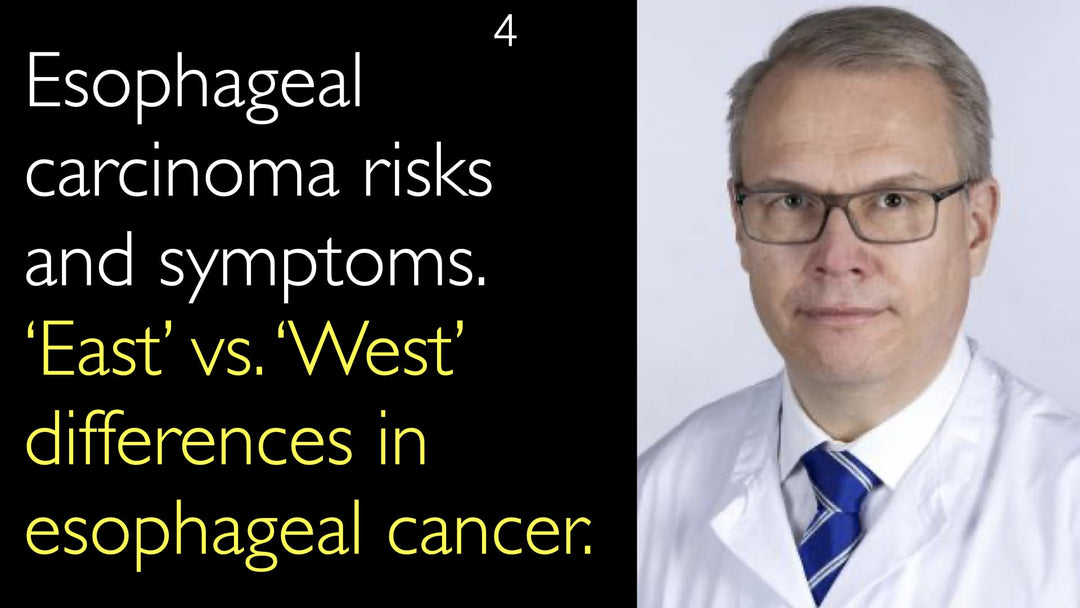O renomado especialista em carcinoma esofágico, Dr. Jari Rasanen, esclarece os sintomas críticos e os fatores de risco associados ao câncer de esôfago. Ele detalha as diferenças marcantes nos tipos da doença entre populações ocidentais e orientais. Dr. Rasanen ressalta que sintomas como dificuldade para engolir costumam surgir apenas em estágios avançados. Enquanto no Ocidente a obesidade e o refluxo figuram como principais fatores de risco, no Oriente destacam-se o consumo de bebidas muito quentes e o tabagismo. A detecção precoce por meio de gastroscopia é fundamental para pacientes com esofagite crônica.
Compreendendo o Câncer de Esôfago: Sintomas, Riscos e Variações Globais
Navegar para a Seção
- Sintomas e Diagnóstico Tardio
- Demografia e Fatores de Risco
- Fatores de Risco no Ocidente versus Oriente
- Tipos Histológicos e Localização
- Importância da Detecção Precoce
- Transcrição Completa
Sintomas e Diagnóstico Tardio
O Dr. Jari Rasanen, médico, aponta os principais sintomas do carcinoma esofágico, que incluem dificuldade para engolir alimentos e, em alguns casos, dor. Um desafio crítico nesse tipo de câncer é que os sintomas geralmente surgem em estágios muito avançados da doença. Essa manifestação tardia complica significativamente o tratamento e afeta o prognóstico do paciente.
Demografia e Fatores de Risco
O Dr. Jari Rasanen, médico, descreve o perfil típico do paciente com carcinoma esofágico. A doença costuma ser diagnosticada tardiamente devido à natureza inespecífica dos sintomas. Em sua discussão com o Dr. Anton Titov, médico, ele ressalta que pessoas com inflamação esofágica crônica precisam de acompanhamento rigoroso. Esses pacientes de alto risco devem realizar gastroscopias periódicas para viabilizar a detecção precoce do câncer.
Fatores de Risco no Ocidente versus Oriente
O Dr. Jari Rasanen, médico, destaca uma importante diferença epidemiológica no câncer de esôfago. Ele explica que os fatores de risco variam drasticamente entre países ocidentais e orientais. No Ocidente, a doença está fortemente associada à obesidade e ao refluxo gastroesofágico decorrente. Já no Oriente, os principais riscos são comportamentais, como o consumo de bebidas muito quentes, tabagismo e álcool. Diferenças genéticas entre as populações também podem influenciar esses padrões.
Tipos Histológicos e Localização
Conforme detalhado pelo Dr. Jari Rasanen, médico, o tipo histológico do câncer de esôfago também varia conforme a região. O carcinoma de células escamosas é mais comum em países orientais e pode ocorrer em qualquer parte do esôfago, embora seja frequente nas porções média e superior. Já o adenocarcinoma predomina no Ocidente. O Dr. Rasanen especifica que o adenocarcinoma quase sempre se localiza na parte distal do esôfago, próximo ao estômago.
Importância da Detecção Precoce
O Dr. Jari Rasanen, médico, conclui com uma recomendação crucial para o cuidado dos pacientes. Como os sintomas surgem tardiamente, o rastreamento proativo é essencial. Ele enfatiza que pessoas com inflamação crônica da mucosa esofágica devem ser acompanhadas com gastroscopias regulares. Essa vigilância é a estratégia mais eficaz para identificar o câncer em estágio inicial e tratável, melhorando assim os resultados para os pacientes.
Transcrição Completa
Dr. Anton Titov, médico: Quais são os sintomas do carcinoma esofágico? E quais são as características demográficas típicas dos pacientes no momento do diagnóstico? Considerando idade, fatores de risco específicos... Sabemos que o carcinoma esofágico costuma ser diagnosticado em estágios avançados. Esse é o problema.
Dr. Jari Rasanen, médico: Geralmente, os pacientes apresentam sintomas quando o câncer de esôfago já está muito avançado. Os sintomas comuns são dificuldade para engolir alimentos. Às vezes, há dor. Mas, frequentemente, quando os sintomas aparecem, a doença já está em estágio bastante avançado.
Dr. Jari Rasanen, médico: Por isso, se um paciente tem inflamação crônica na mucosa esofágica, deve ser acompanhado com gastroscopias. Assim, é possível detectar um possível câncer de esôfago em estágios iniciais.
Dr. Anton Titov, médico: Existem países com fatores de risco específicos para carcinoma esofágico, onde a doença é mais comum? Como bebidas quentes, algum tipo específico de álcool, tabagismo ou outros fatores?
Dr. Jari Rasanen, médico: Há uma diferença significativa entre os tipos de câncer de esôfago no Ocidente e no Oriente. No Ocidente, a doença está relacionada ao refluxo gastroesofágico, que, por sua vez, está associado à obesidade. Basicamente, obesidade e refluxo são os fatores de risco mais importantes nos países ocidentais.
Dr. Jari Rasanen, médico: Por outro lado, no Oriente, o tipo mais comum é o carcinoma de células escamosas. O risco está mais ligado a bebidas quentes, tabagismo e consumo de álcool. Certamente, há diferenças genéticas entre ocidentais e orientais que também ajudam a explicar as variações epidemiológicas.
Dr. Anton Titov, médico: A localização do câncer de esôfago varia entre Oriente e Ocidente, dependendo do tipo histológico?
Dr. Jari Rasanen, médico: Sim, varia. O carcinoma de células escamosas pode aparecer em qualquer parte do esôfago, mas é mais comum nas porções média e superior. Já o adenocarcinoma, predominante no Ocidente, quase sempre se localiza na parte distal do esôfago.




